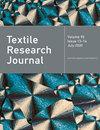Stretch and recovery properties of combined and combination twill based woven fabrics
IF 1.9
4区 工程技术
Q2 MATERIALS SCIENCE, TEXTILES
引用次数: 0
Abstract
Woven fabrics are being used in different forms, ranging from wearable clothing to household activities. Comfort and wearer ease are directly related to the stretch properties, and stretch will be beneficial with recovery performance at a given stress. This study is planned to work on the mechanical and stretch and recovery properties of combined and combination twill woven fabrics. The fabric samples were produced by using 59 tex (10/1 Ne) hemp yarn in both warp and weft directions, and thread density was kept constant in six woven fabric samples. Three different weaves, that is, combination twill weave (2/1 + 1/2 and 3/1 + 2/1), combined twill weave (2/1 + 1/2 and 3/1 + 2/1), and basic twill weaves (2/1 and 3/1) were selected for woven fabric preparation. Dimensional stability and shrinkage, tensile strength, puncture resistance, and stretch and recovery properties of developed woven samples were investigated. It was concluded that the stretch and recovery properties depend on the float and interlacement of yarns in the woven fabric. The combination twill weave structures have excellent stretch and recovery properties because they have the highest float in all samples. Combined twill weave structures have the highest tensile strength and puncture resistance properties. On the other hand, the highest shrinkage values are observed for basic twill weave structures.基于组合斜纹的机织物的拉伸和回复特性
梭织织物的使用形式多种多样,从可穿戴的服装到家居活动,不一而足。舒适度和穿着方便性与拉伸性能直接相关,而拉伸性能将有利于特定应力下的恢复性能。本研究计划对组合斜纹机织物和组合斜纹机织物的机械性能、拉伸性能和恢复性能进行研究。织物样品的经纬向均使用 59 tex(10/1 Ne)麻纱,六种机织物样品的线密度保持不变。机织物制备选择了三种不同的织法,即组合斜纹织法(2/1 + 1/2 和 3/1 + 2/1)、组合斜纹织法(2/1 + 1/2 和 3/1 + 2/1)以及基本斜纹织法(2/1 和 3/1)。研究了所制备机织物样品的尺寸稳定性和收缩率、拉伸强度、抗穿刺性以及拉伸和回复性能。结论是拉伸和回复性能取决于机织物中纱线的浮动和交错。组合斜纹编织结构具有出色的拉伸和回复性能,因为它们在所有样品中都具有最高的浮力。组合斜纹编织结构具有最高的拉伸强度和抗穿刺性能。另一方面,基本斜纹编织结构的收缩值最高。
本文章由计算机程序翻译,如有差异,请以英文原文为准。
求助全文
约1分钟内获得全文
求助全文
来源期刊

Textile Research Journal
工程技术-材料科学:纺织
CiteScore
4.00
自引率
21.70%
发文量
309
审稿时长
1.5 months
期刊介绍:
The Textile Research Journal is the leading peer reviewed Journal for textile research. It is devoted to the dissemination of fundamental, theoretical and applied scientific knowledge in materials, chemistry, manufacture and system sciences related to fibers, fibrous assemblies and textiles. The Journal serves authors and subscribers worldwide, and it is selective in accepting contributions on the basis of merit, novelty and originality.
 求助内容:
求助内容: 应助结果提醒方式:
应助结果提醒方式:


